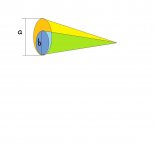looksharp65
Well-known member

Even with all those advantages there is one BIG disadvantage to 7X. They don't bring the bird or object your looking as close as 8X. You don't see as much detail and in my opinion it's almost like your not looking through a binocular.
From: http://www.birdforum.net/showthread.php?p=2379746#post2379746
What about the reach? Well, magnification X at a certain distance resembles viewing the target at 1/X of the distance. If the bird you look at is 20 meters away, the magnification of an 8x makes it look like it's 2.5 meters away. If you're using a 7x, it looks like it is 2.86 meters away, and if it's a 6x it looks like it's 3.33 meters away.
But if you walk 2½ meters forward, the image of the bird through a 7x will have the same size as it had with the 8x at 20 meters. To achieve the same result with a 6x, you go another 2½ meters forward to 15 meters.
At shorter distance, the adjustment of position needed becomes proportionally less.
The longer the distance, the more you need to run forward to achieve that same image size you had with the medium mag binocular. Thus, at longer distance higher magnification pays off a lot more than it does at short distance.
The difference in image size is usually unnoticeable and is, as I prove above, easy to overcome by changing your position vs the object.
Undeniably, a 7x may fall short for long distance viewing, but it is better still to use a 10x for that, hence my statement in post #15.
I should add that my 7x is a 6.5x.
//L





